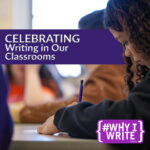 This blog post was written by NCTE member Natalie Kopp as part of a blog series celebrating the National Day on Writing®. To draw attention to the remarkable variety of writing we engage in and to help make all writers aware of their craft, the National Council of Teachers of English has established October 20 as the National Day on Writing®. Resources, strategies, and inclusion in a blog post does not imply endorsement or promotion by NCTE.
This blog post was written by NCTE member Natalie Kopp as part of a blog series celebrating the National Day on Writing®. To draw attention to the remarkable variety of writing we engage in and to help make all writers aware of their craft, the National Council of Teachers of English has established October 20 as the National Day on Writing®. Resources, strategies, and inclusion in a blog post does not imply endorsement or promotion by NCTE.
“I write for the surprise of a sentence. I write with the belief of alchemists.”
–Terry Tempest Williams, “Why I Write”
NCTE’s National Day on Writing® #WhyIWrite campaign asks us to consider the myriad reasons we, and our students, take up the pen.
I start my college composition courses with this same question. During the bustle of the first week’s course overview and introductions, we pause to consider what it means to write, not just in a college writing course but throughout our lives. Students read the powerful flash essay “Why I Write,” by Terry Tempest Williams, and we discuss her list of the thought-provoking, contradictory, and complex reasons that compel her to write. I ask students to think about their own motivations and compose their own list.
As might be expected, students often say that they write as a requirement for school and work. But other themes are more personal, giving me a glimpse into how each student thinks: students write for mental wellness, to preserve memories, and to escape into creative worlds. One student writes “when it feels like no one is listening,” another “to hold a piece of the past in the present,” and yet another “because it’s nice to actually see your own voice, not just hear it.”
I teach students of various ages and backgrounds in community college and public university settings, yet across classes and institutions, I notice a particularly powerful similarity among all the lists. More than almost anything else, students’ reasons indicate that they associate writing with knowledge generation and thought organization. Students consistently say that they write to learn, to better understand complex ideas and feelings, and to work through and organize ideas that they couldn’t make sense of otherwise.
Students’ comments align with what scholars of writing studies identify as key principles that characterize the writing process. In Naming What We Know: Threshold Concepts in Writing Studies, Heidi Estrem asserts that “writing is a knowledge-making activity,” and Collin Brooke and Jeffrey T. Grabill explain that “writing is a technology through which writers create and recreate meaning.”
If you’ve ever journaled or done a free-write, you’ve probably had the experience of discovering something new—a new idea, a new way of understanding a thought, feeling, or topic—while writing. We often associate those moments with the magic, or “alchemy,” of writing, but in reality, they are inherent in the process. The act of writing creates new knowledge, or as Estrem says, “we write to think.”
When Brooke and Grabill refer to writing as a technology, they mean that, like any other tool, writing can be intentionally used to achieve certain goals. It is a tool we as humans have at our disposal to help us think, organize ideas, and generate new knowledge.
In the age of AI, however, there has been a great deal of fear that generative writing technology, such as ChatGPT, will take away students’ ability or desire to generate their own knowledge. Educators have questioned whether AI hurts student creativity, weakens motivation to write and think for oneself, and increases instances of cheating and plagiarism.
To counter these worries, I suggest we encourage students to take time to explore what they experience when they write. The “Why I Write” exercise shows that many students have already discovered that writing is generative, but they may lose sight of this in the classroom space as they consider assignment requirements, deadlines, and grades. By drawing students’ attention to their own lists, I remind them that the power of creation is in their hands. This allows us to begin a course-long conversation about knowledge generation and the capabilities we possess as writers and thinkers.
Doing classroom activities that are specifically aimed at the writing process, rather than the finalized product, can give students more practice using the “technology” of writing while reinforcing its generative nature. Such activities might include in-class freewriting, out-of-class thought or research journaling, and collaborative activities such as concept mapping in small groups. I find that incorporating a variety of activities for generating ideas and developing writing plans gives students the opportunity to find the approaches that work best for them.
When we teach students that they already possess the tools they need to create and recreate meaning and apply knowledge in ways that are theirs alone, my hope is that they approach the writing classroom with a new confidence. As AI technologies provide new opportunities and challenges for students and teachers, writing remains a powerful tool for individuals that is worth practicing.

Natalie Kopp is a PhD candidate in writing, rhetoric, and literacy at the Ohio State University and an adjunct English instructor at Columbus State Community College. Her recent courses have focused on digital storytelling, narratives of the Midwest, and community engagement. Her dissertation project explores nonfiction ethics and conceptions of community and identity in student digital documentary. She can be contacted via email.
It is the policy of NCTE in all publications, including the Literacy & NCTE blog, to provide a forum for the open discussion of ideas concerning the content and the teaching of English and the language arts. Publicity accorded to any particular point of view does not imply endorsement by the Executive Committee, the Board of Directors, the staff, or the membership at large, except in announcements of policy, where such endorsement is clearly specified.

